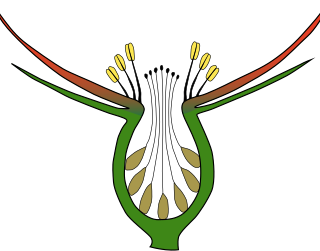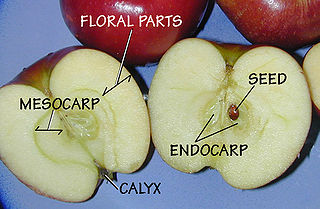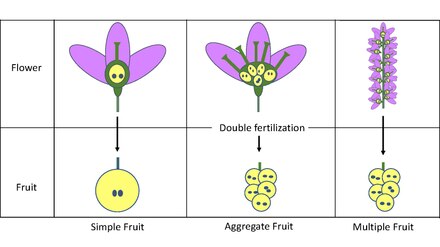
In botany, a fruit is the seed-bearing structure in flowering plants that is formed from the ovary after flowering.

In botany, a drupe is an indehiscent type of fruit in which an outer fleshy part surrounds a single shell of hardened endocarp with a seed (kernel) inside. These fruits usually develop from a single carpel, and mostly from flowers with superior ovaries.

An accessory fruit is a fruit that contains tissue derived from plant parts other than the ovary. In other words, the flesh of the fruit develops not from the floral ovary, but from some adjacent tissue exterior to the carpel. As a general rule, the accessory fruit is a combination of several floral organs, including the ovary. In contrast, true fruit forms exclusively from the ovary of the flower.

A fruit tree is a tree which bears fruit that is consumed or used by animals and humans — all trees that are flowering plants produce fruit, which are the ripened ovaries of flowers containing one or more seeds. In horticultural usage, the term "fruit tree" is limited to those that provide fruit for human food. Types of fruits are described and defined elsewhere, but would include "fruit" in a culinary sense, as well as some nut-bearing trees, such as walnuts.

A nut is a fruit consisting of a hard or tough nutshell protecting a kernel which is usually edible. In general usage and in a culinary sense, a wide variety of dry seeds are called nuts, but in a botanical context "nut" implies that the shell does not open to release the seed (indehiscent).

In botany a capsule is a type of simple, dry, though rarely fleshy dehiscent fruit produced by many species of angiosperms.

An achene, also sometimes called akene and occasionally achenium or achenocarp, is a type of simple dry fruit produced by many species of flowering plants. Achenes are monocarpellate and indehiscent. Achenes contain a single seed that nearly fills the pericarp, but does not adhere to it. In many species, what is called the "seed" is an achene, a fruit containing the seed. The seed-like appearance is owed to the hardening of the fruit wall (pericarp), which encloses the solitary seed so closely as to seem like a seed coat.

In botany, a pome is a type of fruit produced by flowering plants in the subtribe Malinae of the family Rosaceae. Pome fruits consist of a central "core" containing multiple small seeds, which is enveloped by a tough membrane and surrounded by an edible layer of flesh. Pome fruit trees are deciduous, and undergo a dormant winter period that requires cold temperatures to break dormancy in spring. Well-known pomes include the apple, pear, and quince.

In botany, a caryopsis (pl. caryopses) is a type of simple fruit—one that is monocarpellate and indehiscent and resembles an achene, except that in a caryopsis the pericarp is fused with the thin seed coat.

Syconium is the type of inflorescence borne by figs, formed by an enlarged, fleshy, hollow receptacle with multiple ovaries on the inside surface. In essence, it is really a fleshy stem with a number of flowers, so it is considered both a multiple and accessory fruit.

Dehiscence is the splitting of a mature plant structure along a built-in line of weakness to release its contents. This is common among fruits, anthers and sporangia. Sometimes this involves the complete detachment of a part. Structures that open in this way are said to be dehiscent. Structures that do not open in this way are called indehiscent, and rely on other mechanisms such as decay or predation to release the contents.

An aggregate fruit or etaerio is a fruit that develops from the merger of several ovaries that were separated in a single flower. In contrast, a simple fruit develops from one ovary, and a multiple fruit develops from multiple flowers. In languages other than English, the meanings of "aggregate" and "multiple" fruit are reversed, so that "aggregate" fruits merge several flowers. The differences in meaning are due to a reversal in the terminology by John Lindley, which has been followed by most English-language authors.

Multi-fruits, also called collective fruits, are fruiting bodies formed from a cluster of flowers, the inflorescence. Each flower in the inflorescence produces a fruit, but these mature into a single mass. After flowering, the mass is called an infructescence. Examples are the fig, pineapple, mulberry, osage-orange, and jackfruit.

In the flowering plants, an ovary is a part of the female reproductive organ of the flower or gynoecium. Specifically, it is the part of the pistil which holds the ovule(s) and is located above or below or at the point of connection with the base of the petals and sepals. The pistil may be made up of one carpel or of several fused carpels, and therefore the ovary can contain part of one carpel or parts of several fused carpels. Above the ovary is the style and the stigma, which is where the pollen lands and germinates to grow down through the style to the ovary, and, for each individual pollen grain, to fertilize one individual ovule. Some wind pollinated flowers have much reduced and modified ovaries.

In botany, a berry is a fleshy fruit without a stone (pit) produced from a single flower containing one ovary. Berries so defined include grapes, currants, and tomatoes, as well as cucumbers, eggplants (aubergines) and bananas, but exclude certain fruits that meet the culinary definition of berries, such as strawberries and raspberries. The berry is the most common type of fleshy fruit in which the entire outer layer of the ovary wall ripens into a potentially edible "pericarp". Berries may be formed from one or more carpels from the same flower. The seeds are usually embedded in the fleshy interior of the ovary, but there are some non-fleshy exceptions, such as Capsicum species, with air rather than pulp around their seeds.

In botany, a follicle is a dry unilocular fruit formed from one carpel, containing two or more seeds. It is usually defined as dehiscing by a suture in order to release seeds, for example in Consolida, peony and milkweed (Asclepias).
This page provides a glossary of plant morphology. Botanists and other biologists who study plant morphology use a number of different terms to classify and identify plant organs and parts that can be observed using no more than a handheld magnifying lens. This page provides help in understanding the numerous other pages describing plants by their various taxa. The accompanying page—Plant morphology—provides an overview of the science of the external form of plants. There is also an alphabetical list: Glossary of botanical terms. In contrast, this page deals with botanical terms in a systematic manner, with some illustrations, and organized by plant anatomy and function in plant physiology.

Fruits are the mature ovary or ovaries of one or more flowers. They are found in three main anatomical categories: aggregate fruits, multiple fruits, and simple fruits.
















